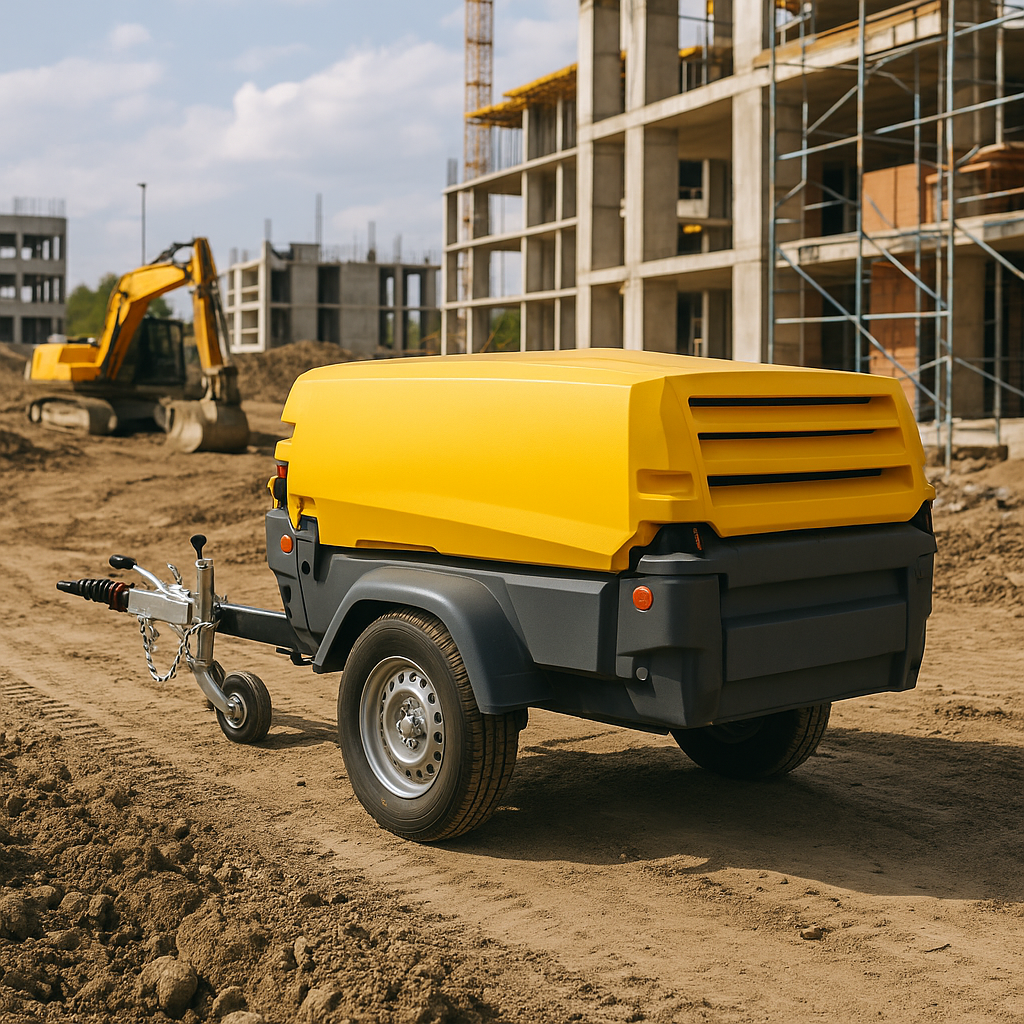
Technical Guide: Choosing a Portable Diesel Compressor
Selecting a portable compressor isn’t just about headline CFM figures. For contractors, blasting operators, and site managers, the correct specification ensures reliability, compliance, and lower total lifecycle costs. Here are the technical factors you should evaluate:
1. Free Air Delivery (FAD)
Definition: The actual volume of air delivered at the outlet, corrected to ISO conditions (20°C, 1 bar abs, 0% humidity).
Key Point: Always distinguish between theoretical displacement and FAD. Some manufacturers advertise piston displacement, which is misleading.
Continuous Delivery: Ask for data showing sustained delivery under load. A compressor rated at 5.0 m³/min may only hold 4.5 m³/min continuously in hot conditions.
2. Operating Pressure Range
Standard site compressors run at 7–10 bar, but blasting and drilling may require up to 12–14 bar.
Some models allow dual-pressure operation via electronic regulation.
Always match compressor output pressure to the demand of your equipment to avoid over-fuelling or tool wear.
3. Fuel Efficiency & Engine Load
Diesel engines (Kubota, Yanmar, Perkins, Deutz) dominate this sector.
Look at specific fuel consumption (SFC), measured in L/hr at rated load.
Stage V-compliant engines use DOC + DPF + SCR systems, which add complexity – factor in AdBlue consumption as well.
A unit with higher efficiency at part-load can save thousands annually in fuel burn.
4. Noise Emissions
Measured as sound pressure level LpA at 7m.
EU Stage V units often fall in the 68–76 dB(A) range.
For urban or night work, check whether the model has a “silenced canopy” option.
5. Cooling System & Duty Cycle
Compressors running sandblasters or multiple pneumatic tools often operate at 100% duty cycle.
Verify cooling capacity of both the engine radiator and aftercooler (if fitted).
An undersized cooling system leads to derating (loss of airflow in hot ambient conditions).
6. Filtration & Aftercoolers
Dry air is critical for blasting and precision tools.
Options include:
Cyclone separators (removes bulk water)
Aftercoolers (reduces discharge temperature close to ambient)
Fine filtration (removes oil aerosols down to <0.01 mg/m³)
Confirm the pressure drop across the filtration train, as this affects usable CFM.
7. Chassis & Tow Compliance
Road tow models must comply with UK Construction & Use Regulations.
Key checks:
Gross vehicle weight (under/over 750kg)
Braked vs unbraked chassis
Lighting, breakaway cable, and tow hitch type
Site tow variants can save weight/cost but are restricted to internal movements.
8. Maintenance Intervals
Compare engine and compressor service intervals (e.g. 500 hr vs 1000 hr).
Check accessibility of filters, belts, and separators.
Machines with modular service kits simplify logistics and reduce downtime.
9. Emissions Compliance
Stage V engines are mandatory on most UK/EU sites.
Verify the type of after-treatment system:
DOC (Diesel Oxidation Catalyst)
DPF (Diesel Particulate Filter – requires regeneration)
SCR (Selective Catalytic Reduction – requires AdBlue)
Non-compliant imports may appear cheaper but can result in site bans.
10. Lifecycle Costing
When comparing units, calculate:
Capex (initial purchase price)
Opex (fuel, AdBlue, filters, oil, consumables)
Residual value after 5–7 years
Downtime risk (based on service network coverage)
A compressor with 5–10% higher efficiency often offsets a higher purchase price within 2 years of use.
Final Thoughts
A suitable portable compressor should be evaluated on air delivery under ISO conditions, true fuel burn, Stage V compliance, cooling capacity, and serviceability. For blasting and heavy-duty site work, focus on continuous-duty capability, aftercooler/filtration options, and chassis compliance for UK roads.
👉 Want to talk about our range of portable compressors? Contact CoolBlast for expert advice.


